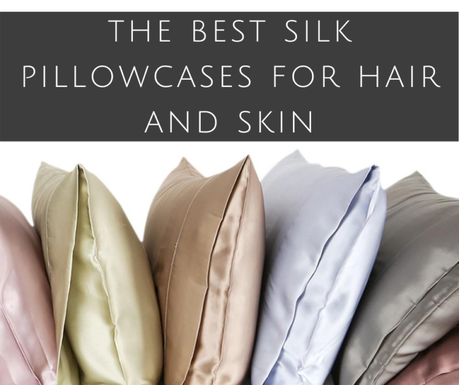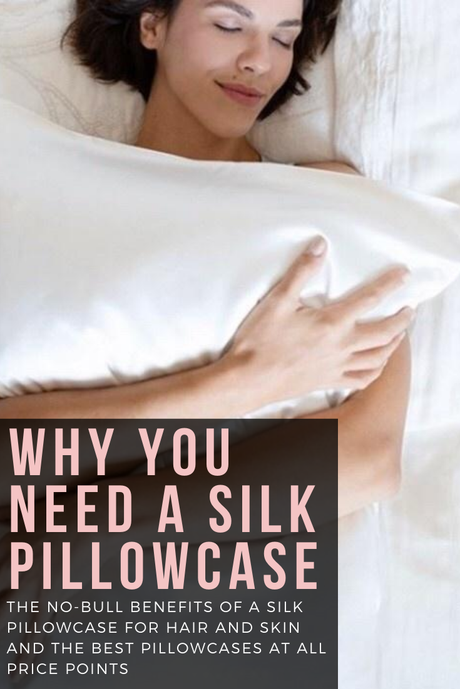
You've likely read on a blog, women's site, or had it screamed to you in an Instagram ad that you should sleep on a silk pillowcase because it prevents creasing of your skin and hair. That it is a must for women with frizzy or curly hair, and it can prevent wrinkles. But does it REALLY work? And come on, silk can't be thrown in the washer and dryer with the rest of the bed linens, is such a pillowcase worth the laundry effort?
The Benefits of a Silk Pillowcase
What makes a silk pillowcase different from your cotton, linen, and jersey sheets is the reduction of friction. Even the softest sheets, if they aren't from silk, will cause minor tugging on your skin and your hair. Yes, it's minor, but you sleep on that pillow 365 nights a year, providing 365 chances for friction which adds up. This friction can cause creases on your skin (have you ever woken up with pillowcase creases on your cheek?) and can also rough up your hair's cuticle causing frizz.
Another benefit to silk pillowcases is that the smooth finish doesn't absorb moisture like traditional cotton pillowcases. This means more of your night cream remains on your face, and your hair also stays more hydrated which also prevents frizz and "bed head."
If you google the benefits of a silk pillowcase, the first few pages of Google are full of sites that sell silk pillowcases. They share that silk pillowcases can add moisture to your skin, they repel dust and fungus, are hypoallergenic, they repel bedbugs, regulate body temperature, wick moisture, cure cancer... okay the last one they don't promote (at least not on the first two pages of Google) but they do make you think silk pillowcases will change your life. A lot of these claims have been debunked or shown to be true but not really beneficial when using the silk as your pillowcase. I am focusing on the skin and hair benefits for silk pillowcases as I've actually seen a benefit.
Does a Silk Pillowcase Really Make a Major Difference?
I have noticed such a difference that I first wrote about the benefits of a silk pillowcase back in 2015 and am updating this post in 2020 to continue to rave about this unexpected beauty product. Back in 2015, I shared that I bought a silk pillowcase because I was trying to embrace my natural hair texture and was dealing with some seriously bad bedhead that couldn't be remedied with a brush. I stated, "Before the pillowcase if I went to sleep with a bit of product in my hair I woke looking a mess. Now, I have been known to do a bit of finger or wood-bristle strategic brushing and be on my way." I also shared that, "My hair is naturally curly, but it's fine and doesn't hold the curl. I can have Shirley Temple ringlets at bedtime and wake looking like Kip Winger. With the pillowcase, I end up looking a bit more like Sammy Hagar AKA something that can be fixed with a spray bottle or a curling iron."
Since then, I gave up on having wavy hair and then in 2019 went head-first into the curly hair community and now have truly curly hair. The nights that I sleep on my regular pillowcase, I wake with points of fluff/frizz where my head hit the pillow that are so bad that I have to completely wet my hair, apply product, and start over. When I use my silk pillowcase, my curls are a bit matted and messy, but they can be reset with a mist of water and some finger curling. Using a silk pillowcase saves so much styling time every morning.
As for the skin element, I do experience it but it's not as dramatic. I don't wake with a greasy imprint of my face on my pillowcase, and I also don't wake with hard creases in the side of my face that was last on the pillow. I can say that it doesn't hurt my skin, but whether it makes longterm major impact, I don't know.
Silk vs. Satin Pillowcases
Before I bought a silk pillowcase, I tried a satin pillowcase, reading it would help just as well as silk in protecting. I liked that satin was machine washable and also cheaper in price. I don't really know if the satin helped my hair because the polyester satin pillowcase was so hot, I'd get all sweaty and uncomfortable and would end up throwing the pillow on the floor. I also found the pillowcase incredibly slippery and would slide off of it if I tossed and turned at night. I am one who sleeps hot in general; if you are not and you don't move a lot when you sleep, you may be fine with a satin pillowcase. Like silk, it also prevents frizz, skin creasing, moisture absorption, and all that jazz. On top of it, satin is a good choice if you are vegan or don't want to use any silk products.
Shop Top-Rated Satin Pillowcases:


What is Mulberry Silk and Is It Better?
Many companies that sell silk pillowcases promote that their products are made with mulberry silk. Mulberry silk is called this because the silkworms are only fed mulberry leaves, which makes the silk they produce pure white in color, made of individual long fibers, and therefore stronger and more refined than other silks. This means a pillowcase or any item made from mulberry silk will be more durable and also will have a tighter weave, creating more of a luster.
Shop Mulberry Silk Pillowcases:



Who Makes the Best Silk Pillowcase?
I have owned silk pillowcases from cheap Amazon retailers, from Etsy sellers, and from fancy brands that sponsor podcasts... and I have found them all to work equally as well in preventing frizz and facial creasing. If you can't afford a $250 pillowcase or even a $50 pillowcase, don't let it stop you from purchasing one. It may not look as nice or hold up as well, but it will still provide the beauty benefits you desire.
However, if you are looking for durability, you need to research the momme of a silk pillowcase. Momme is the method of measuring the weight of silk fabric. The higher the momme, the softer as well as the more durable the fabric. I've found that pillowcases with a higher momme are usually more expensive.
I started with a cheap silk pillowcase and it helped my skin and hair, but after a few washings the fabric began to fray and the seams were falling apart. I bought an expensive silk pillowcase and it was thicker, stronger, and had a more beautiful lustre. I also bought a pillowcase from Etsy that was half the price... and it was just as nice and durable. No matter the pricepoint you're considering, do your research to be sure the price equals the value you will get from your silk pillowcase.
One thing I have found no matter the brand of silk pillowcase... a zipper closure is best. Not only does it keep out dust and allergens from your actual pillow, but silk pillowcases can also be slippery and I've found my pillow slip out of the case when it has the traditional envelope closure.
Shop Top-Rated Silk Pillowcases:


How to Launder a Silk Pillowcase
If you're like me, you may be hesitant to buy a silk pillowcase purely for the laundering aspect. Silk clothing is already high-maintenance, the idea of having a high-maintenance pillowcase that you need to wash regularly sounds dreadful. I don't know if this is the best method, but I take my silk pillowcase, turn it inside out, and wash it in a lingerie bag on the gentle cycle of the machine on cold with my other delicates. I then hang it to dry. This does leave it a bit wrinkles and without its visible sheen, but it still works for preventing frizz, protecting curls, and protecting skin.
I've read that you want a silk pillowcase with at least a momme of 20 to survive even a gentle cycle of your washing machine. You can iron silk on the reverse side using the iron's silk setting to remove wrinkles; a garment steamer is also a great way to quickly get the wrinkles out of a freshly-washed silk pillowcase.
Some retailers have created machine-washable silk pillowcases that are designed to survive the rigors of a traditional tumble in the washer; I have not tried any so not sure how they do. if you have tried one, please share your experience in the comments!

